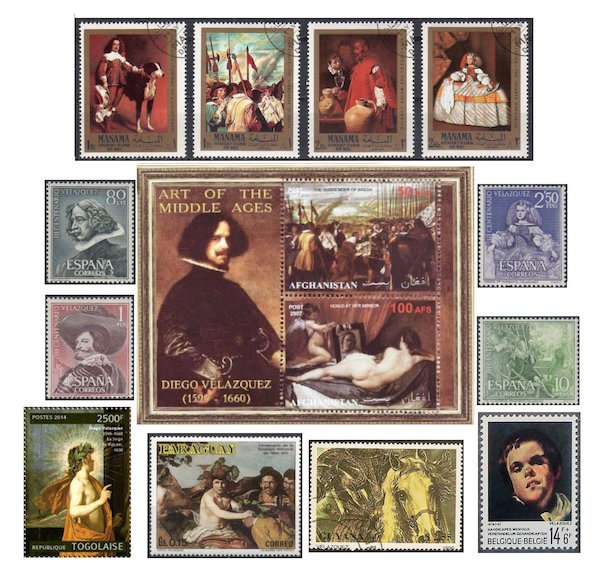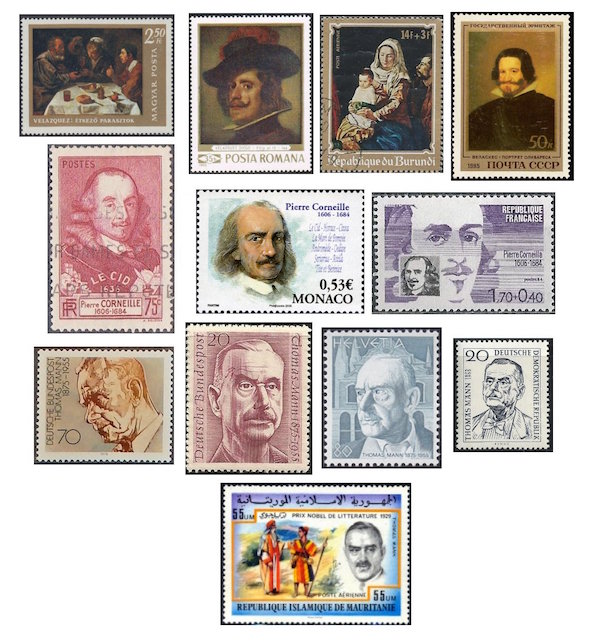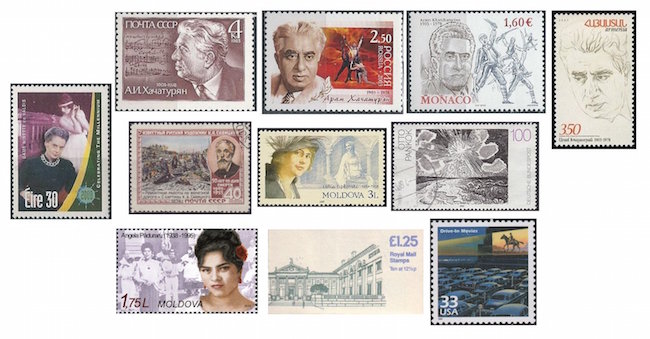The Arts on the Stamps of the World — June 6
An Arts Fuse regular feature: the arts on stamps of the world.

By Doug Briscoe
Five mighty pens—or rather, three pens and two paintbrushes—lead off today’s Arts on the Stamps of the World: Alexander Pushkin, Pierre Corneille, Thomas Mann, Diego Velázquez, and John Trumbull.
Of the fourteen stamps for Alexander Pushkin (6 June [O.S. 26 May] 1799 – 10 February [O.S. 29 January] 1837) seen here, nine are from the Soviet Union, with three of the others stemming from Eastern Europe: Hungary, Romania, and Czechoslovakia. There’s also one from Senegal (!); and why the Republic of Guinea decided to mark the 60th anniversary of the October Revolution with a stamp showing a statue of Pushkin is beyond me, but it’s a nice looking stamp. As with García Lorca yesterday, let’s have a look at some of the musical works that have come about as a result of Pushkin’s writings. I believe it’s safe to say that every important Russian composer without exception has set Pushkin at one time or another. Besides hundreds of song settings, the most important Russian operas, Ruslan and Ludmila (Glinka), Boris Godunov (Mussorgsky), Eugene Onegin and The Queen of Spades (Tchaikovsky), The Tale of Tsar Saltan and The Golden Cockerel (Rimsky-Korsakov) are all based on Pushkin, as are two of Rachmaninov’s three operas, Aleko and The Miserly Knight. There are even Pushkin operas by Suppé (another Queen of Spades) and Leoncavallo (Zingari)! Among the songs, Britten’s late cycle “The Poet’s Echo” (1965) and Shostakovich’s 4 Monologues, Op. 91, deserve mention. Anatoly Liadov wrote an orchestral Polonaise in Memory of Pushkin, and there’s a Pushkin cantata by Glazunov.

The tragedies of the great Pierre Corneille (6 June 1606 – 1 October 1684) were sometimes accompanied by music, as in the case of Andromède (1650), which had a score composed by one Charles Coypeau (1605 – 1677). The libretto for Lully’s Psyché was jointly composed by Corneille (some sources say rather his brother Thomas) with Molière and Quinault. Some verses from this play have been set by Koechlin and Paladilhe. In later centuries only a few of Corneille’s works were brought to the stage in operatic form, the most famous example being Massenet’s Le Cid. The libretti for Handel’s Flavio (1723) and Rodelinda (1725) were also based on Corneille. Two little known operas by Donizetti (1838) and Gounod (1878) were based on Polyeucte, which also inspired a ballet by Marc-Antoine Charpentier (1679) and a concert overture by Paul Dukas (1891). As for the stamps, there are two French and one Monegasque.
The best known opera after Thomas Mann (6 June 1875 – 12 August 1955) is surely Benjamin Britten’s striking score for Death In Venice (book 1912, opera 1973). Then of course there’s the 1971 Luchino Visconti film with Dirk Bogarde. Daphne Du Maurier wrote an homage to the novel in the form of a short story called “Ganymede”, published in her anthology The Breaking Point (1959). Mann’s own profound knowledge of music can be gleaned from much of his writing, nowhere more pointedly than in his great novel Doctor Faustus, whose main character Adrian Leverkühn is a composer. Thomas Mann was awarded the Nobel Prize in Literature in 1929. His three German stamps are joined by one from Switzerland and one from Mauritania, which refers to Mann’s tetralogy Joseph and His Brothers (1926-40).

Our next two subjects have oodles of stamps showing their work. Spanish master Diego Velázquez was baptized on June 6, 1599. He entered the royal service of King Philip IV in 1623. Apart from two trips to Italy he spent his whole life in Spain (though he met Rubens there) and died on August 6, 1660. The stamps are innumerable, and I can show but a small sampling of them. Notice that the central minisheet comes from Afghanistan!
For the first 22 years of American postage stamp history, the subject matter was restricted exclusively to presidents (Washington and Lincoln, with the odd Jefferson and Jackson thrown in) and Ben Franklin. As an experiment in 1869, a bit of variety was introduced with stamps showing an eagle and shield, a locomotive, a Pony Express rider, and John Trumbull’s famous painting of the signing of The Declaration of Independence (1817). People didn’t like them, and no more such stamps were issued for another 23 years. I supply here an image of one of the two Declaration of Independence issues of 1869—one had a 15-cent denomination, this one is 24 cents. A mint copy of either one would set you back thousands of dollars today. Trumbull’s historical paintings and portraits of Washington and others have since featured frequently on US stamps. Two of them were used in a set of ten stamps commemorating Washington’s bicentennial in 1932. For the American bicentennial four large sheets of five stamps each were issued; two of the four paintings selected were Trumbull’s, and I thought I’d show The Surrender of Cornwallis at Yorktown. The Declaration of Independence was the other, and it was also shown in a se-tenant strip of four stamps that can be seen at the top of our collage, right next to the 1869 stamp. Trumbull himself was honored on a stamp of 1968, with a detail from the extreme right side of his Battle of Bunker’s Hill (which event Trumbull had witnessed personally). The bulk of the painting, the full title of which is The Death of General Warren at the Battle of Bunker’s Hill (1786), is seen on a later stamp (lower left). Other Trumbull works are seen here, some on a few stamps from Romania. John Trumbull (June 6, 1756 – November 10, 1843) was born in Connecticut and lost the use of one eye in a childhood accident. He went to Harvard, was a personal aide to George Washington, and studied painting with Benjamin West.

Armenian composer Aram Khachaturian (6 June [O.S. 24 May] 1903 – 1 May 1978) made a name for himself with his 1936 Piano Concerto, written for Lev Oborin and championed by William Kapell, and the succeeding Violin Concerto for David Oistrakh (1940). His most famous work is the ballet Gayane of 1942, and the most famous section of that score is the ubiquitous Sabre Dance. The lovely Adagio from the ballet was famously used in Stanley Kubrick’s 2001: A Space Odyssey. (I think the title is pronounced GAH-ya-neh—or maybe ga-ya-NEH—but I’ve never been able to confirm that.) Khachaturian’s name is frequently joined with those of Shostakovich and Prokofiev as targets of the notorious Soviet “anti-formalism” attacks, but, if I may be permitted a snarky aside, I never thought any of his music was in the same league. (I’ve always regretted that the short-lived Kapell devoted so much time to the big trashy Concerto when he might have played and recorded so many other works of greater merit.) Not to end on a carping note, that Adagio shoor is purty.
Irish-born British ballet dancer Edris Stannus (1898 – 8 March 2001) legally changed her name to Ninette de Valois at a very early age, danced with Serge Diaghilev’s Ballets Russes, and established several ballet schools, including the first ballet school in Turkey. Her Abbey Theatre School of Ballet in Dublin was formed at the request of W.B. Yeats, no less. The Academy of Choreographic Art, which she founded in 1926, later became the Royal Ballet School, and the Royal Ballet made its United States debut with Margot Fonteyn in 1949. Ninette de Valois died in London at the age of 102.

The father of Russian realist painter Konstantin Savitsky (6 June 1844 – 13 February 1905) worked as a doctor in a boys’ high school (gymnasium) and lived in the same building, so Savitsky’s early childhood must have been on the noisy side. Both his parents suddenly died when he was about ten, and he was taken by an uncle from his native Taganrog to Latvia. He went to the Imperial Academy of Arts in Saint Petersburg and met Ilya Repin and a number of the other painters whose work we’ve seen here, including Ivan Shishki and Viktor Vasnetsov. Although he was richly rewarded with prizes at the Academy, he was one of those who joined the rebellious group the Peredvizhniki, or Wanderers, which I mentioned here recently when writing about Grigoriy Myasoyedov. Savitsky’s painting Repairing the Railroad (1874), reproduced on the stamp, is seen as one of the first to portray the lives of the working class in Russia. The portrait of the artist also seen on this stamp is by his colleague Nikolai Grandkovsky (1864-1907).
One online source gives Lydia Lipkowska’s birthdate as June 6 (O.S. May 25), 1882, but Polish Wikipedia says April 28, 1884. Between engagements at the Mariinsky Theatre Lipkowska sang at the Met in the 1909-11 seasons, her debut being in La traviata opposite Caruso. During an appearance with the Boston Opera Company, the Lenox Hotel created two dishes in her name, the “cup Lydia” and the “Soufflé a la Lipkowska.” (For more on Lipkowska see my entry for 28 April.)

German artist Otto Pankok (6 June 1893 – 10 October 1966) studied in Düsseldorf, Weimar, the Netherlands, and Paris before being called up to serve for three years in World War I. Shortly after the war, he was one of the founders of the Young Rhineland group. Pankok was one of those artists maligned by the Nazis, with some 56 of his paintings removed from museums and a number of them included in the notorious entartete Kunst exhibit of 1937. In the ensuing years he and his wife retired from public life into a personal exile in the Teutoburg Forest. They returned to Düsseldorf—their home there had been bombed during the war—and Pankok took up teaching at the Academy of Fine Arts, where one of his students was Günter Grass. (The character of Professor Kuchen in The Tin Drum is an homage to Pankok.) His paintings tended to be monochromatic, and Sea and Sun (see the stamp) is typical of his work, which also involved printmaking, woodcuts, monotypes, and over 200 mostly small bronze sculptures.
Moldovan folk and popular music singer Angela Păduraru (1938 – 26 July 1995) was famous in her country—then, of course, the Soviet Republic of Moldavia—in the 1960s and 70s. She made over 200 recordings. A festival in her name has taken place since 2010. The 75th anniversary of her birth was acknowledged with a postage stamp in 2013. An example of her singing can heard on this YouTube file.
It was on this day in 1683 that the Ashmolean Museum in Oxford opened. It was the world’s first university museum. There’s no stamp, but a booklet cover depicts a portion of the building.
The very first drive-in movie theater opened in Camden, New Jersey on 6 June, 1933, and by golly there’s a stamp for that topic, too.
A graduate of the University of Massachusetts with a B.A. in English, Doug Briscoe worked in Boston classical music radio, at WCRB, WGBH, and WBUR, for about 25 years, beginning in 1977. He has the curious distinction of having succeeded Robert J. Lurtsema twice, first as host of WGBH’s weekday morning classical music program in 1993, then as host of the weekend program when Robert J.’s health failed in 2000. Doug also wrote liner notes for several of the late Gunther Schuller’s GM Recordings releases as well as program notes for the Boston Classical Orchestra. For the past few years he’s been posting a Facebook “blog” of classical music on stamps of the world, which has now been expanded to encompass all the arts for The Arts Fuse.
